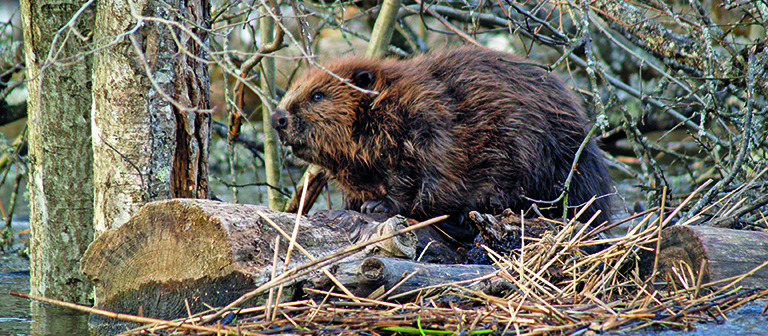Beavers to become protected species in Scotland

Castor fiber by Aivar Ruukel in Soomaa National Park Estonia
From 1 May 2019 European beaver (Castor fiber) will be added to the list of European Protected Species of Animals, protected under Scottish law, making it an offence to kill, injure or capture them.
The long-awaited and controversial move comes after protracted debate in Scotland about how their numbers should be managed. According to Scottish Natural Heritage (SNH), the beaver population has tripled in Scotland over the past six years to 430 beavers in more than 100 active territories on Tayside. Scottish farmers have raised concerns about the damage caused to agricultural land from their dam-building.
In February SNH published Interim Beaver Management Advice, recognising that in some places and situations the activities of beavers can have negative impacts on other interests such as farms, gardens, or other land. SNH has stated that sometimes this can be easily managed to prevent damage, such as by fencing vulnerable areas or protecting individual trees, and in others there is the potential for more novel techniques, such as beaver dam ‘deceivers’. SNH is currently providing free and expert advice to help people experiencing problems and where possible to provide measures to minimise damage through a beaver mitigation scheme.
Meanwhile in Essex, European beaver have been released in a fenced enclosure covering four hectares of woodland on the Spains Hall estate in Finchingfield, near Braintree as part of natural flood management trials being part funded by the Environment Agency and Anglian Eastern RFCC.
Beavers and flood and water management
A formerly native species, the return of European beaver to the UK after an absence of ~500 years is welcomed by many. Their ability to create wetland habitat through dam building has been cited as a potential benefit to reducing flood risk and improving water quality and ecology in the right circumstances. The European beaver builds fewer dams than its North American cousin, and it does so generally in streams to maintain water levels above the entrance to its burrow. Dams are built of tree trunks, branches and mud, and are about one metre in height and rarely longer than fifteen metres. They are usually breached by flood waters each year. However, Beavers and flood and water management unlike its North American cousin it prefers to dig burrows in riverbanks in which to nest rather than building lodges of piled logs. The entrance to the burrow is typically below the waterline, with the nest chambers typically 0.4-0.5 metres in height positioned 0.3-0.7 metres above the burrow entrance. (See Natural England: The feasibility and acceptability of reintroducing the European beaver to England 2009 [pdf])
However, this activity can also cause damage and thus endanger safety, especially in lowland areas, such as by undermining flood defences and watercourse embankments, or collapsed dams lodging in culverts and ditches. Water managers will need to find measures to make critical areas and infrastructure less attractive to beavers and mitigate their damage. This means having a regulatory system and resources in place that enables flood Risk Management Authorities to take proportionate measures swiftly where they cause damage and thereby endanger safety. ADA is following with interest research in this area by colleagues in the Netherlands, who already face the risk from these large rodents undermining their dikes. With a better understanding of the behaviour of beavers in the field, the Dutch Union of Water Boards hope to make it easier to detect excavation damage, and possible to ‘steer’ them in such a way that damage to flood defences can be prevented.
Archive
- March 2025
- February 2025
- January 2025
- December 2024
- November 2024
- October 2024
- September 2024
- August 2024
- July 2024
- June 2024
- May 2024
- April 2024
- March 2024
- January 2024
- December 2023
- November 2023
- October 2023
- September 2023
- August 2023
- July 2023
- June 2023
- May 2023
- April 2023
- March 2023
- February 2023
- January 2023
- December 2022
- September 2022
- August 2022
- July 2022
- June 2022
- May 2022
- April 2022
- March 2022
- February 2022
- January 2022
- December 2021
- November 2021
- September 2021
- July 2021
- May 2021
- March 2021
- February 2021
- January 2021
- December 2020
- November 2020
- October 2020
- September 2020
- August 2020
- July 2020
- May 2020
- April 2020
- March 2020
- February 2020
- January 2020
- December 2019
- November 2019
- October 2019
- September 2019
- August 2019
- July 2019
- June 2019
- May 2019
- April 2019
- March 2019
- February 2019
- January 2019
- December 2018
- November 2018
- October 2018
- September 2018
- August 2018
- July 2018
- June 2018
- May 2018
- April 2018
- March 2018
- February 2018
- January 2018
- December 2017
- November 2017
- October 2017
- September 2017
- August 2017
- July 2017
- June 2017
- May 2017
- April 2017
- March 2017
- February 2017
- January 2017
- October 2016
- September 2016
- August 2016
- July 2016
- June 2016
- May 2016
- April 2016
- March 2016
- January 2016
